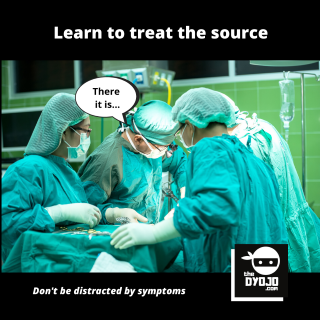Leadership development must include the skill to address dysfunction. Treating the sources of dysfunction Treating the sources of dysfunction When someone near you sneezes, do you brace yourself and think, “Great, now I’m going to get sick?” You experience the external symptom and know it reveals that this person has either had a reaction to something or that they are ill. The sneeze could carry particles of some disease that will spread to yourself and others. You may say, “Bless you,” or offer your favorite remedies for the common cold. You know that when someone sneezes (symptom) there is an underlying source. On the other hand, in business, you experience dysfunction all the time and yet get sidetracked by thinking solely about the symptoms. Symptoms are what attract our attention yet sources are where solutions must be applied. As a person in a position of leadership, it is important to intentionally develop your ability to decipher the nuances between symptoms and sources if you want to be effective with leading your team. Understanding the cost of dysfunction as a leader.What is the difference between a symptom and the source when addressing dysfunction? The online Oxford Dictionary definition of a symptom (noun) is, “A physical or mental feature which is regarded as indicating a condition of disease, particularly such a feature that is apparent to the patient.” When used in a sentence, "Dental problems may be a symptom of other illness." As noted above, you as a patient begin to experience tooth pain. The pain is a symptom of some source. It could be a cavity, a sensitive tooth or something much greater such as decay or infection. Ibuprofen may temporarily treat the symptom of pain but it will not address the source. After a few days of increasing discomfort, you decide to go to the dentist to determine the issue and discuss solutions. Interestingly, the online Oxford Dictionary uses another example which is apropo both to our culture as well as the business environment, “A sign of the existence of something, especially of an undesirable situation.” The importance of developing leadership skills that will address organizational dysfunction.The second sentence utilization from Oxford states, "The government was plagued by leaks—a symptom of divisions and poor morale." In the example, leaks (symptom) in the government were caused by divisions and poor morale (source). I would add that division and poor morale are symptoms of lack of trust and unwillingness to set aside ego for the greater good. When human interactions are involved, the source versus symptom discussion has layers of complexity.
As a person in a position of leadership, you can either peel back the layers of symptoms to address sources or the layers of symptoms can build until they overwhelm your resources and suck the life from your organization. Explore beneath the surface to determine what sources in your team are causing these dysfunctional symptoms. Addressing one layer of symptoms and sources will likely lead to opening another layer. Three key areas of focus for leaders who want to reduce dysfunction in their teams:
0 Comments
Leave a Reply. |
AuthorThoughts on personal and professional development. Jon Isaacson, The Intentional Restorer, is a contractor, author, and host of The DYOJO Podcast. The goal of The DYOJO is to help growth-minded restoration professionals shorten their DANG learning curve for personal and professional development. You can watch The DYOJO Podcast on YouTube on Thursdays or listen on your favorite podcast platform.
Archives
March 2023
Categories
All
<script type="text/javascript" src="//downloads.mailchimp.com/js/signup-forms/popup/unique-methods/embed.js" data-dojo-config="usePlainJson: true, isDebug: false"></script><script type="text/javascript">window.dojoRequire(["mojo/signup-forms/Loader"], function(L) { L.start({"baseUrl":"mc.us5.list-manage.com","uuid":"b9016446bd3c6a9f0bd835d4e","lid":"83282ffb9e","uniqueMethods":true}) })</script>
|
Jon Isaacson |
Connect. Collaborate. Conquer.
© COPYRIGHT 2015. ALL RIGHTS RESERVED.
|



 RSS Feed
RSS Feed